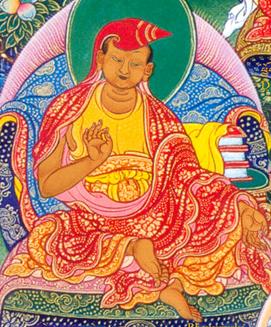Heart of the Middle Way: Difference between revisions
Jump to navigation
Jump to search
mNo edit summary |
mNo edit summary |
||
| Line 1: | Line 1: | ||
[[Image:Bhavaviveka.JPG|frame|]] | [[Image:Bhavaviveka.JPG|frame|]] | ||
'''The Heart of the Middle Way''' (Skt. ''Madhyamaka-hṛdaya''; [[Wyl.]] ''dbu ma’i snying po'') is a [[Madhyamika]] treatise by [[Bhavaviveka]]. Its auto-commentary is called the ''[[Blaze of Reason]]'' (''Tarkajvāla''). | '''The Heart of the Middle Way''' (Skt. ''Madhyamaka-hṛdaya''; [[Wyl.]] ''dbu ma’i snying po'') is a [[Madhyamika]] treatise by [[Bhavaviveka]]. Its auto-commentary is called the ''[[Blaze of Reason]]'' (''Tarkajvāla''). | ||
==Quotations== | |||
{{:Quotations: Bhavaviveka, Heart of the Middle Way}} | |||
==Further Reading== | ==Further Reading== | ||
*Malcolm David Eckel, ''Bhaviveka and His Buddhist Opponents: Chapters 4 and 5 of the verses on the Heart of the Middle Way (Madhyamakahrdayakarikah)'', Harvard Oriental Series, 2009 | *Malcolm David Eckel, ''Bhaviveka and His Buddhist Opponents: Chapters 4 and 5 of the verses on the Heart of the Middle Way (Madhyamakahrdayakarikah)'', Harvard Oriental Series, 2009 | ||
==References== | |||
<References /> | |||
[[Category: Texts]] | [[Category: Texts]] | ||
[[Category:Madhyamika]] | [[Category:Madhyamika]] | ||
Revision as of 12:39, 21 November 2011

The Heart of the Middle Way (Skt. Madhyamaka-hṛdaya; Wyl. dbu ma’i snying po) is a Madhyamika treatise by Bhavaviveka. Its auto-commentary is called the Blaze of Reason (Tarkajvāla).
Quotations
ཡང་དག་ཀུན་རྫོབ་རྣམས་ཀྱི་སྐས། །
མེད་པར་ཡང་དག་ཁང་ཆེན་གྱི། །
སྟེང་དུ་འགྲོ་བར་བྱ་བ་ནི། །
Trying to reach the great mansion
Of the authentic nature of reality
Without the steps of the authentic relative
Is not an approach the wise should take.[1]
- Bhāvaviveka, Heart of the Middle Way, III, 12
Further Reading
- Malcolm David Eckel, Bhaviveka and His Buddhist Opponents: Chapters 4 and 5 of the verses on the Heart of the Middle Way (Madhyamakahrdayakarikah), Harvard Oriental Series, 2009